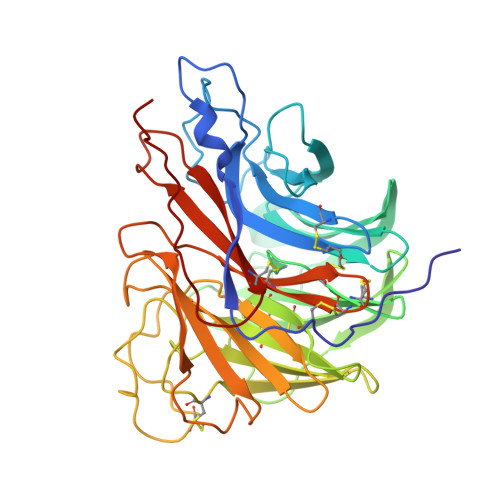Influenza B virus neuraminidase can synthesize its own inhibitor.
Burmeister, W.P., Henrissat, B., Bosso, C., Cusack, S., Ruigrok, R.W.(1993) Structure 1: 19-26
- PubMed: 8069621
- DOI: https://doi.org/10.1016/0969-2126(93)90005-2
- Primary Citation of Related Structures:
1NSC, 1NSD - PubMed Abstract:
Neuraminidase, one of the two surface glycoproteins of influenza virus, cleaves terminal sialic acid residues from glycolipids or glycoproteins. Its crystal structure is known at high resolution, but the mechanism of glycosyl hydrolysis remains unclear. We have determined the crystal structure at 1.8 A resolution of two complexes of influenza B/Beijing neuraminidase containing either the reaction product, sialic acid, or the transition state analogue inhibitor, 2,3-dehydro-2-deoxy-N-acetylneuraminic acid (DANA). The sialic acid is bound in a distorted 'boat' conformation closely resembling that of bound DANA, stabilized by a conserved tyrosine residue (Tyr408). This distortion also gives rise to a suicidal side reaction that converts sialic acid to DANA at a low rate. The mechanism of neuraminidase action is distinct from that of other known glycosyl hydrolases. Substrate distortion appears to be the driving force in glycosyl bond hydrolysis and the proton required for catalysis can probably be donated by water, rather than by residues in the active site, thus allowing the enzyme to operate at high pH. The side reaction converting sialic acid to DANA appears reasonably favourable, and it is unclear how this is minimized by the enzyme.
Organizational Affiliation:
EMBL Grenoble Outstation, Grenoble, France.

















